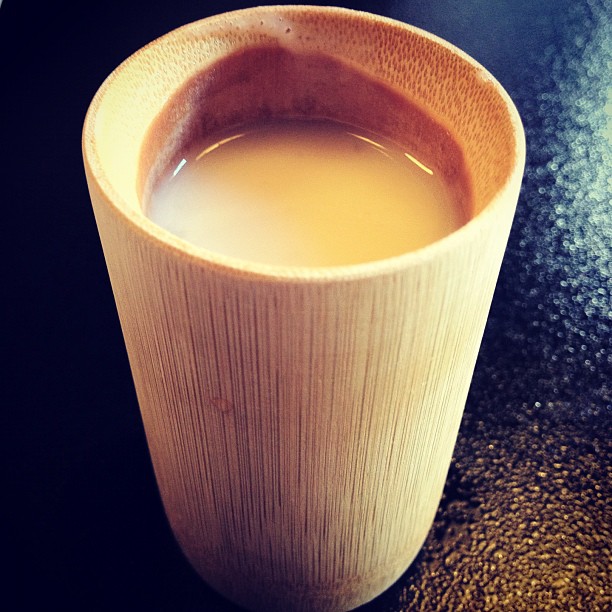AMAZAKE
In Japan, convenience stores are a popular destination for locals due to their vast selection of snacks and drinks. While sake is a well-known alcoholic beverage in Japan, there is another rice-based drink that is even more popular: amazake. The name “amazake” translates to “sweet sake,” and it is a delicious way to enjoy the health benefits of sake without experiencing a hangover.
Amazake is a type of rice drink that is made from rice and is sweet. It is a white color and has a thick consistency and you can drink it cold or hot. Amazake is made with koji, which is a type of fungus that is used to make alcoholic drinks like sake. But because amazake is made with rice, it is not alcoholic. Amazake is traditionally consumed during Japanese festivals , there is also a special amazake festival held at Kyoto’s Umenomiya Taisha shrine in February, where amazake is made and used in ceremonies and are offered to visitors.
Nowadays amazake can be enjoyed, hot or cold, all year round and can also be mixed with other flavors or used in savory dishes. Naturally sweet non-alcoholic amazake made with rice malt can be enjoyed by children, pregnant women, and those who are breastfeeding. Sake lees amazake is “the leftover material after pressing fermented rice during the manufacture of sake” and is often used in cooking and marinades as a seasoning.

History of amazake and types
Amazake has a history of more than 1,000 years. In ancient times it was used as a noble offering, and even today, it is enjoyed as a ceremonial drink on New Year’s Eve, Momo-no-Sekku (Peach Festival) and other occasions.
Amazake’s existence is mentioned in history books beginning with the “Nihon Shoki (Chronicles of Japan)” compiled in the Nara period (710–794). According to the chronicles, around the year 288, an indigenous people of ancient times offered kosake to Emperor Ojin. Kosake is a liquor made from rice and koji (malted rice), and the roots of koji amazake can be traced to this type of liquor. Ama-no-tamu-zake, is described in the “Chronicles of Japan,” is also considered a prototype of amazake. This sake was brewed to celebrate the birth of a child by the goddess Konohana Sakuyahime, mentioned in Japanese mythology.
In the Muromachi period (1336–1573), amazake peddlers emerged, and during the Edo period, koji amazake became widespread among the general public. Its production method seemed to have already been established, and many samurai made amazake as their side jobs. Amazake made from Koji is made without any added sugar, its gentle sweetness is attained instead through saccharification of the koji.
Today, amazake is often thought of as a winter drink, but it was consumed year-round by the masses in across Japan. It was a necessity, especially in summer, and was valued as a nutritional supplement to prevent summer fatigue and relieve exhaustion. The shogunate set a maximum price for amazake in recognizing its benefits and this affordability helped promote its widespread use.

Health benefits of amazake
Fermented foods like amazake are gaining popularity for their numerous health benefits. According to a 2017 study published in Critical Reviews in Food Science and Nutrition, the microbes involved in the fermentation process offer various benefits, including antioxidant, antibacterial, anti-inflammatory, anti-diabetic, and anti-atherosclerotic activities.
Amazake is brimming with health benefits and can regularly be enjoyed as part of a balanced diet — it is an excellent source of thiamin, niacin, and B vitamins. It can be a perfect drink if you feel unwell as it is easy on the stomach and provides the essential nutrients your body needs. It’s also beloved by the beauty community because of its anti-ageing properties and benefits to the skin, hair, and nails.
Full of healthy gut bacteria, amazake is high in enzymes and bacteria that help with digestion, and whether it’s made from white or brown rice, it has a high fibre content, although amazake from brown rice has a higher fibre content than amazake made from white rice. This means it’s also an excellent source of selenium, manganese, magnesium, and phosphorus. Food scientist Abby Thiel has even referred to it as the “Potable IV” due to its nutritional value. Amazake is also very slowly digested, meaning it has a low glycemic index, keeping you full for longer and contributing to a steady blood-sugar level
So overall amazake is believed to have anti-aging properties, promote good skin, aid digestion, boost metabolism, fight fatigue, and strengthen the immune system.
 Previous Article
Previous Article Next Article
Next Article
- Categories:
- Share :
 Previous Article
Previous Article Next Article
Next Article
